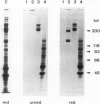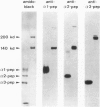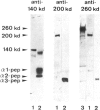Abstract
We have isolated type VI collagen, a transformation-sensitive glycoprotein of the extracellular matrix, in an intact, disulfide-bonded form. The protein contains a 200 kd subunit and two different 140 kd subunits in a stoichiometric ratio. Based on the amount of hydroxyproline and hydroxylysine, the sensitivity to bacterial collagenase and the cross-reactivity with antibodies to pepsin-extracted type VI collagen, we have identified the 200 kd subunit as the alpha 3(VI) chain and the two 140 kd subunits as the alpha 1(VI) and alpha 2(VI) chains. The alpha 3(VI) chain is synthesized by cells in culture as a precursor of 260 kd, while no precursor form of the other two chains could be detected.
Full text
PDF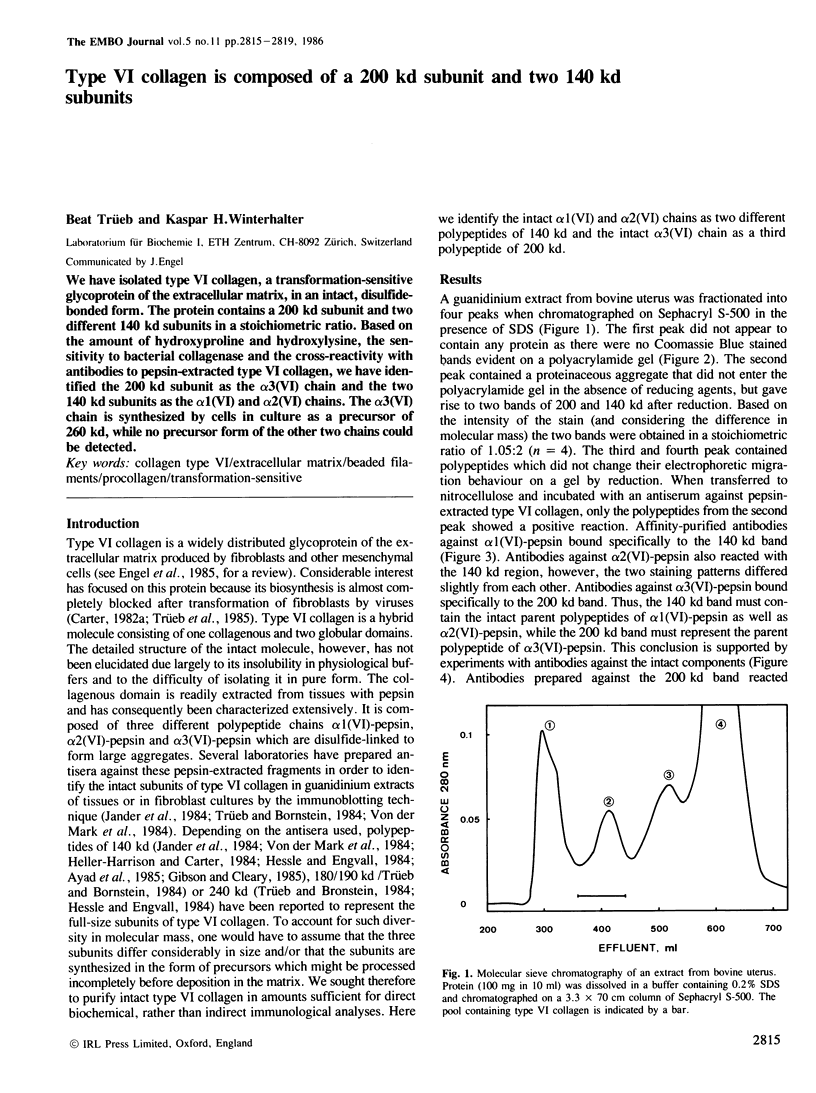
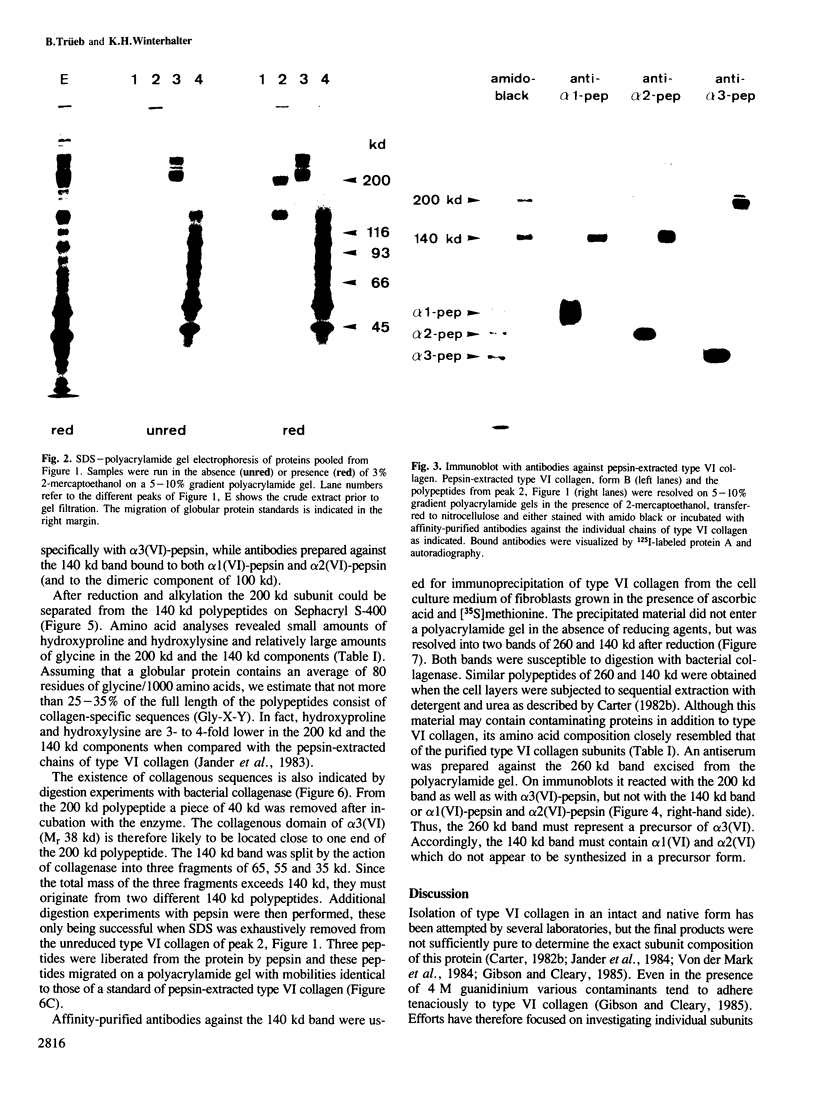

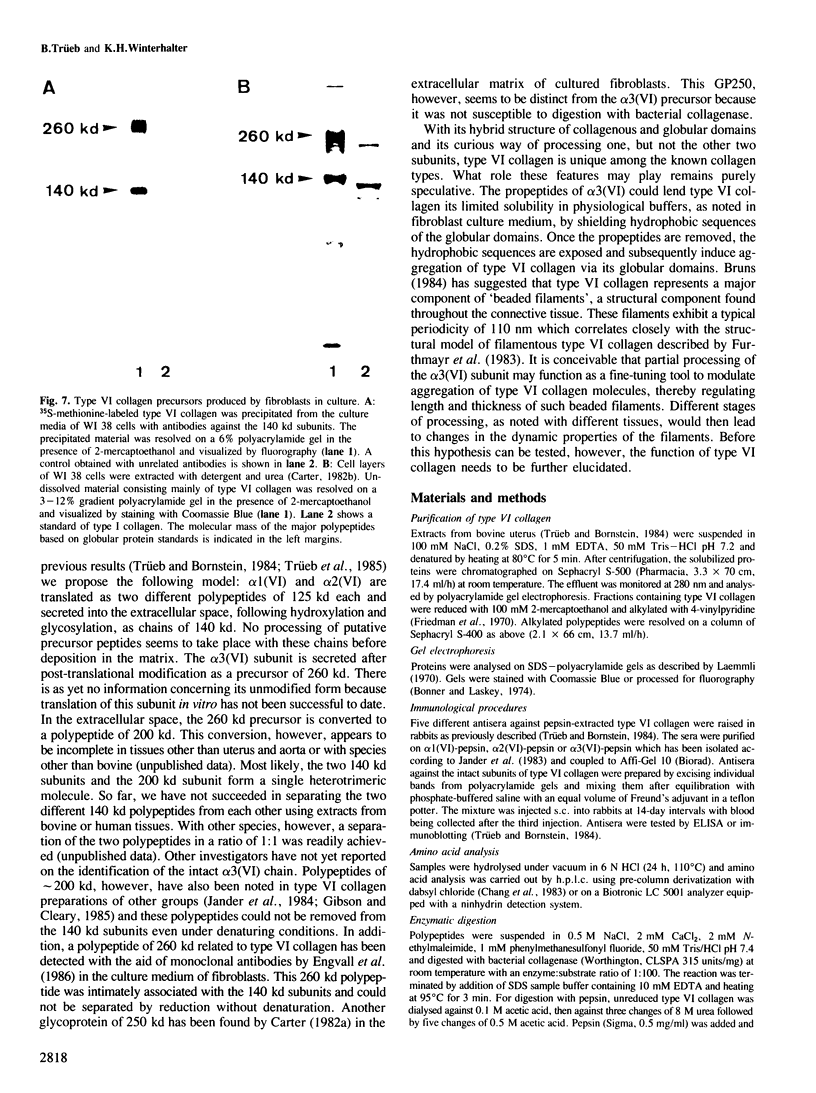

Images in this article
Selected References
These references are in PubMed. This may not be the complete list of references from this article.
- Aumailley M., von der Mark H., Timpl R. Size and domain structure of collagen VI produced by cultured fibroblasts. FEBS Lett. 1985 Mar 25;182(2):499–502. doi: 10.1016/0014-5793(85)80362-8. [DOI] [PubMed] [Google Scholar]
- Ayad S., Chambers C. A., Shuttleworth C. A., Grant M. E. Isolation from bovine elastic tissues of collagen type VI and characterization of its form in vivo. Biochem J. 1985 Sep 1;230(2):465–474. doi: 10.1042/bj2300465. [DOI] [PMC free article] [PubMed] [Google Scholar]
- Bonner W. M., Laskey R. A. A film detection method for tritium-labelled proteins and nucleic acids in polyacrylamide gels. Eur J Biochem. 1974 Jul 1;46(1):83–88. doi: 10.1111/j.1432-1033.1974.tb03599.x. [DOI] [PubMed] [Google Scholar]
- Bruns R. R. Beaded filaments and long-spacing fibrils: relation to type VI collagen. J Ultrastruct Res. 1984 Nov;89(2):136–145. doi: 10.1016/s0022-5320(84)80010-6. [DOI] [PubMed] [Google Scholar]
- Carter W. G. The cooperative role of the transformation-sensitive glycoproteins, GP140 and fibronectin, in cell attachment and spreading. J Biol Chem. 1982 Mar 25;257(6):3249–3257. [PubMed] [Google Scholar]
- Carter W. G. Transformation-dependent alterations is glycoproteins of extracellular matrix of human fibroblasts. Characterization of GP250 and the collagen-like GP140. J Biol Chem. 1982 Nov 25;257(22):13805–13815. [PubMed] [Google Scholar]
- Chang J. Y., Knecht R., Braun D. G. Amino acid analysis in the picomole range by precolumn derivatization and high-performance liquid chromatography. Methods Enzymol. 1983;91:41–48. doi: 10.1016/s0076-6879(83)91009-1. [DOI] [PubMed] [Google Scholar]
- Engel J., Furthmayr H., Odermatt E., von der Mark H., Aumailley M., Fleischmajer R., Timpl R. Structure and macromolecular organization of type VI collagen. Ann N Y Acad Sci. 1985;460:25–37. doi: 10.1111/j.1749-6632.1985.tb51154.x. [DOI] [PubMed] [Google Scholar]
- Engvall E., Hessle H., Klier G. Molecular assembly, secretion, and matrix deposition of type VI collagen. J Cell Biol. 1986 Mar;102(3):703–710. doi: 10.1083/jcb.102.3.703. [DOI] [PMC free article] [PubMed] [Google Scholar]
- Friedman M., Krull L. H., Cavins J. F. The chromatographic determination of cystine and cysteine residues in proteins as s-beta-(4-pyridylethyl)cysteine. J Biol Chem. 1970 Aug 10;245(15):3868–3871. [PubMed] [Google Scholar]
- Furthmayr H., Wiedemann H., Timpl R., Odermatt E., Engel J. Electron-microscopical approach to a structural model of intima collagen. Biochem J. 1983 May 1;211(2):303–311. doi: 10.1042/bj2110303. [DOI] [PMC free article] [PubMed] [Google Scholar]
- Gibson M. A., Cleary E. G. CL glycoprotein is the tissue form of type VI collagen. J Biol Chem. 1985 Sep 15;260(20):11149–11159. [PubMed] [Google Scholar]
- Heller-Harrison R. A., Carter W. G. Pepsin-generated type VI collagen is a degradation product of GP140. J Biol Chem. 1984 Jun 10;259(11):6858–6864. [PubMed] [Google Scholar]
- Hessle H., Engvall E. Type VI collagen. Studies on its localization, structure, and biosynthetic form with monoclonal antibodies. J Biol Chem. 1984 Mar 25;259(6):3955–3961. [PubMed] [Google Scholar]
- Jander R., Rauterberg J., Glanville R. W. Further characterization of the three polypeptide chains of bovine and human short-chain collagen (intima collagen). Eur J Biochem. 1983 Jun 1;133(1):39–46. doi: 10.1111/j.1432-1033.1983.tb07427.x. [DOI] [PubMed] [Google Scholar]
- Jander R., Troyer D., Rauterberg J. A collagen-like glycoprotein of the extracellular matrix is the undegraded form of type VI collagen. Biochemistry. 1984 Jul 31;23(16):3675–3681. doi: 10.1021/bi00311a016. [DOI] [PubMed] [Google Scholar]
- Laemmli U. K. Cleavage of structural proteins during the assembly of the head of bacteriophage T4. Nature. 1970 Aug 15;227(5259):680–685. doi: 10.1038/227680a0. [DOI] [PubMed] [Google Scholar]
- Trüeb B., Bornstein P. Characterization of the precursor form of type VI collagen. J Biol Chem. 1984 Jul 10;259(13):8597–8604. [PubMed] [Google Scholar]
- Trüeb B., Lewis J. B., Carter W. G. Translatable mRNA for GP140 (a subunit of type VI collagen) is absent in SV40 transformed fibroblasts. J Cell Biol. 1985 Feb;100(2):638–641. doi: 10.1083/jcb.100.2.638. [DOI] [PMC free article] [PubMed] [Google Scholar]
- Zimmermann D. R., Trüeb B., Winterhalter K. H., Witmer R., Fischer R. W. Type VI collagen is a major component of the human cornea. FEBS Lett. 1986 Mar 3;197(1-2):55–58. doi: 10.1016/0014-5793(86)80297-6. [DOI] [PubMed] [Google Scholar]
- von der Mark H., Aumailley M., Wick G., Fleischmajer R., Timpl R. Immunochemistry, genuine size and tissue localization of collagen VI. Eur J Biochem. 1984 Aug 1;142(3):493–502. doi: 10.1111/j.1432-1033.1984.tb08313.x. [DOI] [PubMed] [Google Scholar]



